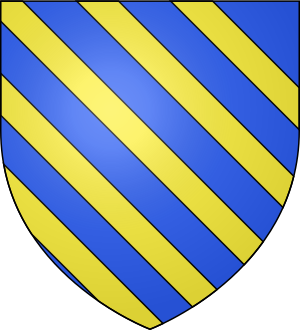William II, Lord of Béthune facts for kids
Quick facts for kids William II, Lord of Béthune |
|
|---|---|
 |
|
| Ancient coat of arms of the House of Béthune | |
| Spouse(s) | Mathilda of Dendermonde |
| Issue | |
| Robert VII, Lord of Béthune Guillaume III |
|
| Noble family | House of Bethune |
| Father | Robert V, Lord of Béthune |
| Mother | Adelaide of Saint-Pol |
| Died | April 1214 |
William II, Lord of Béthune, also known as William the Red, was an important French nobleman who lived a long time ago. He was the ruler, or Lord, of lands like Béthune, Richebourg, and Warneton. He also had a special role as the protector of the Abbey of St. Vaast, a large church near Arras.
Contents
His Family and Brothers
William II belonged to a very powerful family called the House of Bethune. Their main home was in Béthune, a place in the Artois region of France.
William was the second son of Lord Robert V, who was also called Robert the Red. His mother was Adelaide of Saint-Pol. William had several brothers:
- Robert VI (who died in 1193)
- Baldwin (who died in 1212)
- Conon (who died around 1219 or 1220). Conon was famous as a troubadour, which was a poet and musician. He was also a brave crusader.
- Jean (who died in 1219). He became a bishop in a place called Cambrai.
Adventures and Crusades
William II and his older brother Robert VI went on a special journey called a pilgrimage in 1177. They traveled with Count Philip I of Flanders to the Holy Land. This was a religious trip to places important in Christianity. When they arrived in the Kingdom of Jerusalem, William and Robert wanted to marry the king's sisters, Sibylla and Isabella. But King Baldwin IV of Jerusalem said no.
In 1191, the Béthune family went on another big journey. This time, William, his younger brothers Baldwin and Conon, and their father joined Count Philip I on the Third Crusade. A crusade was a religious war fought by European Christians to take back the Holy Land. During this crusade, both Count Philip I and William's father, Robert V, sadly passed away.
After his brother Robert VI died without children in 1193, William II became the new Lord of Béthune. He married a woman named Mathilda. She was the heir to lands in Dendermonde. William and Mathilda had several children together. Their son Daniel later became Lord after William. Another son, John, married a powerful woman who was the Countess of Saint-Pol.
Loyalty and the Fourth Crusade
The Béthune family had a tough choice to make. There was a big disagreement between King Philip II of France and Count Baldwin IX of Flanders. They were fighting over who was the rightful ruler of the Artois region. William II and his oldest son Daniel decided to support the King of France. But William's younger brothers and his son Robert VII chose to support the Count of Flanders. This showed how families could be divided by politics back then.
On February 23, 1200, William II and his brother Conon set off on another crusade, the Fourth Crusade. Conon became very famous for his brave actions during this time. William was also there when the crusaders captured Constantinople in April 1204. Constantinople was a very important city. Count Baldwin IX of Flanders was even chosen to be the first Emperor of the new Latin Empire there.
After a terrible battle called the Battle of Adrianople, where William was not present, he decided to return home. About 7,000 other crusaders also went back. His brother Conon and a Cardinal tried very hard to convince William to stay in Constantinople, but he left. Conon stayed and died there years later.
His Children
William II and his wife Mathilda of Dendermonde had seven children. The first five were born by 1194:
- Daniel, Lord of Béthune (died 1227). He married Eustacia of Châtillon.
- Robert VII, Lord of Béthune (died 1248). He married Elizabeth of Morialmé.
- Baldwin of Béthune, who passed away when he was young and was never married.
- Alice of Béthune (died 1256). She married Walter II of Nanteuil before 1215.
- Maud of Béthune (died 1251). She married four times: first Baldwin III of Comines, then Godfrey III of Breda, then Gilbert of Zottegem, and finally Arnold V of Diest.
- William III of Bethune (died 1243). He married Elizabeth of Roesbrugge. Some of his family members still live today as Lords of Meulebeke.
- John of Béthune (died 1238). He married Elizabeth, Countess of Saint-Pol. She was the mother of Eustacia, who married his brother Daniel.
His Death
William II passed away in April 1214. This was just a few months before a very important battle called the Battle of Bouvines.

